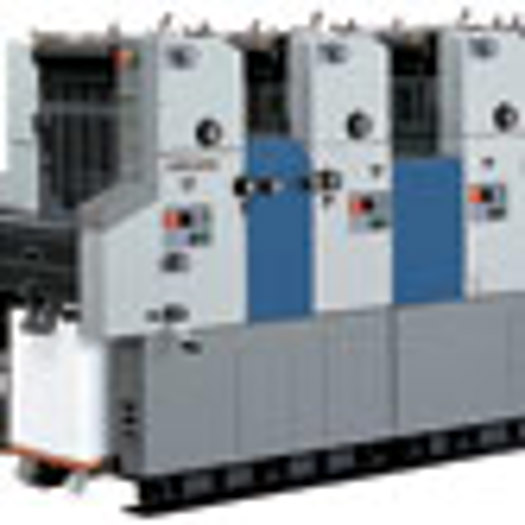As a response to these requests, the 11,000 sheets per hour (sph) 512 was born. Not only did it hit the spot in terms of the demand for two-colour portrait work, it also presented an affordable alternative to the higher specification four-
colour models.
Neil Handforth, sales and marketing director for Apex Digital Graphics, the UK distributor for Ryobi, says that the new machine was popular from the outset. “It gave the option for those entering the 52cm landscape market, or moving up to two colours, the chance to do so with a shallower financial step.”
Perfect registration
The 512 is a five-cylinder configuration machine with double-size impression cylinders, and as there is no transfer cylinder, the registration, according to Apex, is perfect. Beginning life as a conventional dampening machine, it was upgraded to a continuous dampening press in 1997. Although the 512 has limited automation, makeready times are relatively quick, thanks to the push-button set-up.
“The 512 specifications were considered quite beefy at the time and it also handles heavier stock such as card and gloss with no marking,” says Handforth. “It can run stocks from 0.04-0.4mm”, he adds. Although Ryobi has no official figures on how many 512 models were sold in the UK, it estimates the number runs into the hundreds.
Beyond an enhanced dampening system, the 512 was not upgraded in any other capacity. “To upgrade it further would have meant too much overlap with the 520 series,” explains Handforth. The 520 is the next step up from the 512 and is one of Ryobi’s flagship models – the 512 was discontinued in 2003 and replaced by the 522HE and 524HE.
These models two- and four-colour models were built on the side frames and castings of the 522, but offer a greater range of automation options, such as semi-automatic plate change and automatic blanket washing.
Part-exchange policy
Ryobi has a part-exchange policy, dependent on age and condition, and have sold on a handful of 512 presses secondhand. However, this is a rare occurrence rather than the norm and secondhand dealers seem to be a better source for used 512 machines.
Philip Idle Graphic Machinery is a Bradford-based dealer that specialises in Ryobi presses. Owner Philip Idle says that there is a healthy demand for 512 presses. “They are popular as they represent good value for money and have dot for dot registration.” He explains that they are particularly popular with printers attempting two-colour work for the first time. “Customers with the 3302 portrait presses often buy it in order to jump up a grade and be able to handle higher-quality or more demanding work.”
Idle adds that there are no inherent problems with used 512s but, as with any secondhand purchase, it is important to look at the impression count and overall condition of the machine. A used 512 can be sold and fully installed, including operator training from between £14,000 and £17,000. This will include a three-month parts and labour guarantee.
As there is much commonality on Ryobi presses from model to model, it is fairly easy to get spare parts, even on the older models. There are also 30 field-based Ryobi technicians in the UK and, given that many 512’s are still under service contracts with Ryobi, there should be no problems dealing with any technical issues that occur.
SPECIFICATIONS
Speed 11,000sph
Max paper size 520x365mm
Stock range 0.04-0.4mm
Price
Used: £14,00-£17,000
(with full delivery and installation)
What to look for
• Impression count
• Overall condition
Ryobi 512
In the early 90s, Ryobi found itself facing a dilemma. Its customers that were using the single-colour 500K machine were increasingly asking for a two-colour press, while customers that were using its 3302 two-colour portrait machine were trying to meet to the greater demand for landscape printing.





